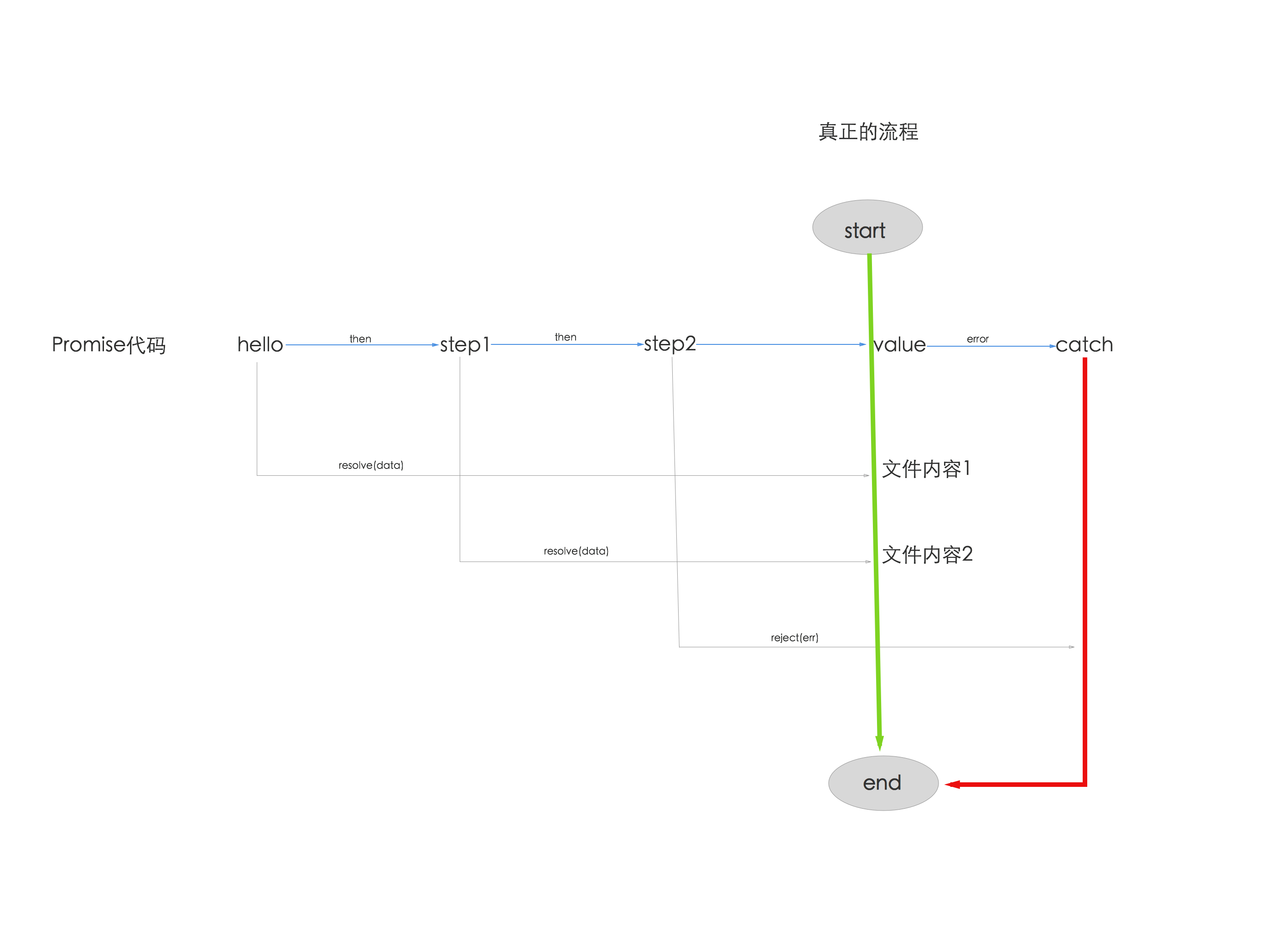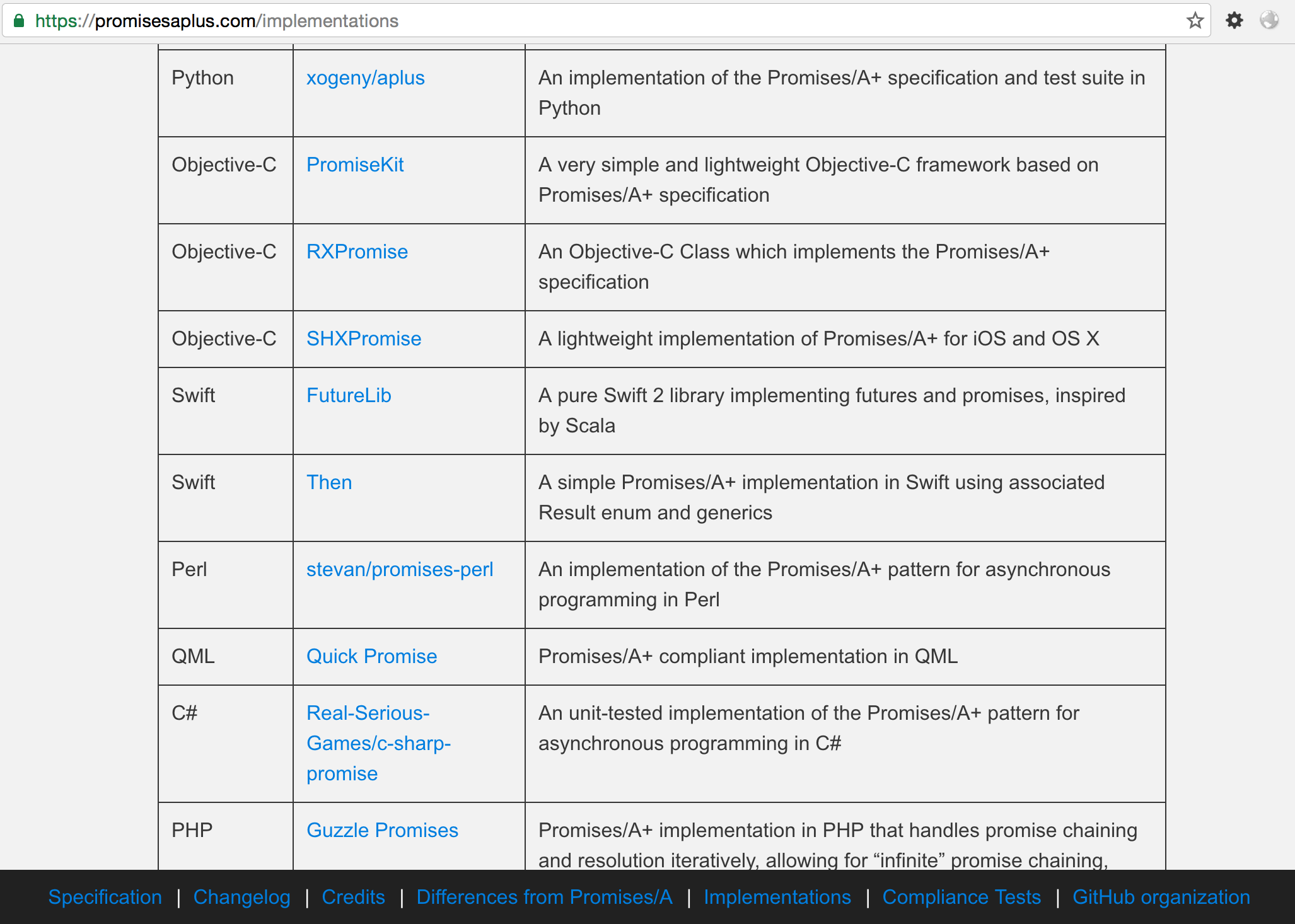# Promise/a+规范
顺序执行的代码和错误有限的回调方式都是js引擎默认支持的,这部分大家会调用接口,无太多变化,而Promise是对callback的思考,或者说改良方案,目前使用非常普遍,这里详细讲解一下。
## Node.js里的Promise
promise最早是在commonjs社区提出来的,当时提出了很多规范。比较接受的是promise/A规范。后来人们在这个基础上。提出了promise/A+规范,也就是实际上的业内推行的规范。es6也是采用的这种规范。
> The Promise object is used for asynchronous computations. A Promise represents an operation that hasn't completed yet, but is expected in the future.
Promise对象用于异步技术中。Promise意味着一个还没有完成的操作(许愿),但在未来会完成的(实现)。

在Node.js 0.12里实现9/11,在6.2和7实现100%,中间版本实现了10/11。所以Node.js对Promise的支持是非常好的,0.12之后的绝大部分版本都支持的不错。
Promise 的最大优势是标准,各类异步工具库都认同,未来的 async/await 也基于它,用它封装 API 通用性强,用起来简单。
要想知道node.js有哪些比较好的promise实现,最好的办法就是看一下最知名的bluebird库的[benchmark](http://bluebirdjs.com/docs/benchmarks.html)里比较里哪些。
* async@1.5.0
* babel@5.8.29
* davy@1.0.1
* deferred@0.7.3
* kew@0.7.0
* lie@3.0.1
* neo-async@1.6.0
* optimist@0.6.1
* promise@7.0.4
* q@1.4.1
* rsvp@3.1.0
* streamline@1.0.7
* text-table@0.2.0
* vow@0.4.11
* when@3.7.4
## Promise是什么?
> A promise is an abstraction for asynchronous programming. It’s an object that proxies for the return value or the exception thrown by a function that has to do some asynchronous processing. — Kris Kowal on JSJ
Promise表示一个异步操作的最终结果。与Promise最主要的交互方法是通过将函数传入它的then方法从而获取得Promise最终的值或Promise最终最拒绝(reject)的原因。
* 递归,每个异步操作返回的都是promise对象
* 状态机:三种状态转换,只在promise对象内部可以控制,外部不能改变状态
* 全局异常处理
定义
~~~
var promise = new Promise(function(resolve, reject) {
// do a thing, possibly async, then…
if (/* everything turned out fine */) {
resolve("Stuff worked!");
}
else {
reject(Error("It broke"));
}
});
~~~
## 术语
* Promises Promise规范自身
* promise对象 promise对象指的是 Promise 实例对象
* ES6 Promises 如果想明确表示使用 ECMAScript 6th Edition 的话,可以使用ES6作为前缀(prefix)
* Promises/A+ Promises/A+。 这是ES6 Promises的前身,是一个社区规范,它和 ES6 Promises 有很多共通的内容。
* Thenable 类Promise对象。 拥有名为.then方法的对象。
## hello promise
给出一个最简单的读写文件的api实例,它是error-first风格的典型api
async/promise/hello.js
~~~
// callbacks
var fs = require("fs");
fs.readFile('./package.json', (err, data) => {
if (err) throw err;
console.log(data.toString());
});
~~~
下面,我们把它变成promise的简单示例
async/promise/hellopromise.js
~~~
// callbacks to promise
var fs = require("fs");
function hello (file) {
return new Promise(function(resolve, reject){
fs.readFile(file, (err, data) => {
if (err) {
reject(err);
} else {
resolve(data.toString())
}
});
});
}
hello('./package.json').then(function(data){
console.log('promise result = ' + data)
}).catch(function(err) {
console.log(err)
})
~~~
这二段代码执行效果是一模一样的,唯一的差别是前一种写法是Node.js默认api写法,以回调为主,而后一种写法,通过返回promise对象,在fs.readFile的回调函数,将结果延后处理。
这就是最简单的promise实现
形式
~~~
new Promise(function(resolve, reject){
})
~~~
参数
* resolve 解决,进入到下一个流程
* reject 拒绝,跳转到捕获异常流程
调用
~~~
hello('./package.json').then(function(data){
})
~~~
全局处理异常
~~~
hello('./package.json').then(function(data){
}).catch(function(err) {
})
~~~
结论
> Promise核心:将callback里的结果延后到then函数里处理或交给全局异常处理
## 封装api的过程
还是以上面的fs.readFile为例
~~~
fs.readFile('./package.json', (err, data) => {
if (err) throw err;
console.log(data.toString());
});
~~~
参数处理:除了callback外,其他东西都放到新的函数的参数里
~~~
function hello (file) {
...
}
~~~
返回值处理:返回Promise实例对象
~~~
function hello (file) {
return new Promise(function(resolve, reject){
...
});
}
~~~
结果处理:通过resolve和reject重塑流程
~~~
function hello (file) {
return new Promise(function(resolve, reject){
fs.readFile(file, (err, data) => {
if (err) {
reject(err);
} else {
resolve(data.toString())
}
});
});
}
~~~
我们知道所有的Node.js都是error-first的callback形式,通过上面的例子,我们可以肯定是所有的Node.js的API都可以这样来处理,只要它们遵守Promise规范即可。
## 每个函数的返回值都是Promise对象
为了简化编程复杂性,每个函数的返回值都是Promise对象,这样的约定可以大大的简化编程的复杂。
它可以理解为是递归的变种思想应用,只要是Promise对象,就可以控制状态,就可以支持then方法,参数还是Promise对象,这样就可以无限个Promise对象链接在一起。
~~~
// callbacks to promise
var fs = require("fs");
function hello (file) {
return new Promise(function(resolve, reject){
fs.readFile(file, (err, data) => {
if (err) {
reject(err);
} else {
resolve(data.toString())
}
});
});
}
function world (file) {
return new Promise(function(resolve, reject){
fs.readFile(file, (err, data) => {
if (err) {
reject(err);
} else {
resolve(data.toString())
}
});
});
}
function log(data){
return new Promise(function(resolve, reject){
console.log('promise result = ' + data)
resolve(data)
});
}
hello('./package.json').then(log).then(function(){
return world('./each.js').then(log)
}).catch(function(err) {
console.log(err)
})
~~~
这里可以看出
* `hello`、`world`、`log` 返回单个Promise对象
* `hello('./each.js').then(log)` 返回流程链
无论是单个,还是流程链的返回值都是Promise对象,那么它就是一样的。
## 链式的thenable
每个promose对象都有then方法,也就是说,then方法是定义在原型对象Promise.prototype上的。它的作用是为Promise实例添加状态改变时的回调函数。
一般实现,类似于
~~~
Promise.prototype.then = function(sucess, fail) {
this.done(sucess);
this.fail(fail);
return this;
};
~~~
它的返回值是this,这就是为什么then可以链式操作的原因。
then的2个参数
* sucess是fulfilled状态的回调函数
* fail是rejected状态的回调函数
一般都是穿sucess回调函数即可。
## 状态转换
一个Promise必须处在其中之一的状态:pending, fulfilled 或 rejected.
* pending: 初始状态, 非 fulfilled 或 rejected.
* fulfilled: 完成(成功)的操作.
* rejected: 拒绝(失败)的操作.
这里从pending状态可以切换到fulfill状态,也可以从pengding切换到reject状态,这个状态切换不可逆,且fulfilled和reject两个状态之间是不能互相切换的。
一定要注意的是,只有异步操作的结果,才可以决定当前是哪一种状态,任何其他操作都无法改变这个状态。
Promise对象可以理解为一个乐高积木,它对下一个流程,传送状态和具体结果。

如果是pending状态,则promise:
* 可以转换到fulfilled或rejected状态。
如果是fulfilled状态,则promise:
* 不能转换成任何其它状态。
* 必须有一个值,且这个值不能被改变。
如果是rejected状态,则promise可以:
* 不能转换成任何其它状态。
* 必须有一个原因,且这个值不能被改变。
”值不能被改变”指的是其identity不能被改变,而不是指其成员内容不能被改变。
## reject和resove流程再造
前面讲了,每个函数的返回值都是Promise对象,每个Promise对象都有then方法,这是它可以递归思路的解决办法。
那么问题来了,如何在连续的操作步骤里,完成流程再造呢?这其实才是异步流程控制最核心的问题。
我们知道Promise的使用形式如下:
~~~
new Promise(function(resolve, reject){
})
~~~
下面仍然使用fs的例子,见reflow.js
`way 1`:简单模式
~~~
hello('./package.json').then(function(data){
console.log('way 1:\n')
return new Promise(function(resolve, reject){
console.log('promise result = ' + data)
resolve(data)
});
}).then(function(data){
return new Promise(function(resolve, reject){
resolve('1')
});
}).then(function(data){
console.log(data)
return new Promise(function(resolve, reject){
reject(new Error('reject with custom err'))
});
}).catch(function(err) {
console.log(err)
})
~~~
这是一个常规的例子,就是在then里面的promise对象里,通过resolve将流程进行到下一步,在reject的时候抛出异常。这里面的每一个promise对象里都可以这样做,那么是不是这个操作流程就是可控的了?
`way 2`:嵌套模式
~~~
hello('./package.json').then(function(data){
console.log('\n\nway 2:\n')
return new Promise(function(resolve, reject){
console.log('promise result = ' + data)
resolve(data)
}).then(function(data){
return new Promise(function(resolve, reject){
resolve('1')
});
}).catch(function(err) {
console.log(err)
})
}).then(function(data){
console.log(data)
return new Promise(function(resolve, reject){
reject(new Error('reject with custom err'))
});
}).catch(function(err) {
console.log(err)
})
~~~
这里的做法是,把第一个then和第二个then合并到一个流程里。这样做的好处是,这个流程也可以考虑单独处理异常。为了某些粒度更新的异步处理,是非常有好处的。
`way 3`:嵌套模式的refact清晰版
~~~
var step1 = function(data){
console.log('\n\nway 3:\n')
return new Promise(function(resolve, reject){
console.log('promise result = ' + data)
resolve(data)
}).then(function(data){
return new Promise(function(resolve, reject){
resolve('1')
});
}).catch(function(err) {
console.log(err)
})
}
var step2 = function(data){
console.log(data)
return new Promise(function(resolve, reject){
reject(new Error('reject with custom err'))
});
}
hello('./package.json').then(step1).then(step2).catch(function(err) {
console.log(err)
})
~~~
把每个独立的操作抽成函数,然后函数的返回值是Promise对象,这样就可以在真正的流程链里随意组织了。
它们就好比是积木一样,可以让逻辑更清楚,让代码更具可读性和可维护性。如果再极端点,每个操作都放到独立文件里,变成模块,是不是更爽呢?
`way 4`:final版,把每个独立的操作放到独立文件里,变成模块
原理: 使用`require-directory`
根据commonjs规范,require只能引用某一个文件,当一个文件夹里有很多文件,每一个都去require是很麻烦的,`require-directory`就是一个便捷模块,可以把某个文件夹内的多个文件挂载到一个对象。
原理,递归遍历文件,读取具体文件,如果是遵循commonjs规范的模块,就挂载在它的返回值对象上。
比如reflow/tasks/index.js
~~~
var requireDirectory = require('require-directory');
module.exports = requireDirectory(module);
~~~
这样`reflow/tasks`下的所有遵循commonjs规范的模块都可以挂载
reflow/tasks/hello.js
~~~
var fs = require("fs");
module.exports = function hello (file) {
return new Promise(function(resolve, reject){
fs.readFile(file, (err, data) => {
if (err) {
reject(err);
} else {
resolve(data.toString())
}
});
});
}
~~~
这其实和之前的定义是一模一样的,唯一差别就是变成了模块,使用了module.exports来导出。
其他的step1和step2以此类推,下面我们卡一下具体调用的代码
~~~
var tasks = require('./tasks')
tasks.hello('./package.json').then(tasks.step1).then(tasks.step2).catch(function(err) {
console.log(err)
})
~~~
给出具体的流程图

首先`require('./tasks')`获得tasks目录下的所有操作任务定义,然后在下面的Promise流程里处理,可以看出定义和实现分离,让代码有更好的可读性。
如果,这时我们恰好需要调整step1和step2的顺序,是不是非常的简单?
~~~
var tasks = require('./tasks')
tasks.hello('./package.json').then(tasks.step2).then(tasks.step1).catch(function(err) {
console.log(err)
})
~~~
更多好处,自行体会吧,这里就不做更多解释了。
## 错误处理
常用的处理方式是全局处理,即所有的异步操作都由一个catch来处理
~~~
promise.then(function(result) {
console.log('Got data!', result);
}).catch(function(error) {
console.log('Error occurred!', error);
});
~~~
当然,then方法的第二个参数也是可以的
~~~
promise.then(function(result) {
console.log('Got data!', result);
}).then(undefined, function(error) {
console.log('Error occurred!', error);
});
~~~
如果有多个then配对的reject函数呢?是不是可以更加灵活?这其实就要取决于你的业务复杂程度里。
错误处理最简单的办法是在promise里使用try/catch的语句。在try/catch块中,它可能去捕获异常,并显示处理它:(TODO: 重写个更简单例子)
~~~
try {
throw new Error('never will know this happened')
} catch (e) {}
~~~
在promises里可以这样写
~~~
readFile()
.then(function (data) {
throw new Error('never will know this happened')
})
~~~
为了打印errors,这里以简单的.then(null, onRejected)语句为例
~~~
readFile()
.then(function (data) {
throw new Error('now I know this happened')
})
.then(null, console.error)
~~~
类库包括一些暴露error的其他选项。比如Q就提供了done方法,可以再次跑出error异常的。
链式写法很方便,可以随意组合,
api/catch.js
~~~
var p1 = new Promise(function(resolve, reject) {
resolve('Success');
});
p1.then(function(value) {
console.log(value); // "Success!"
return Promise.reject('oh, no!');
}).catch(function(e) {
console.log(e); // "oh, no!"
// return Promise.reject('oh, no! 2');
}).then(function(){
console.log('after a catch the chain is restored');
}, function () {
console.log('Not fired due to the catch');
});
~~~
执行
~~~
$ node api/catch.js
Success
oh, no!
after a catch the chain is restored
~~~
api/catch2.js
~~~
var p1 = new Promise(function(resolve, reject) {
resolve('Success');
});
p1.then(function(value) {
console.log(value); // "Success!"
return Promise.reject('oh, no!');
}).catch(function(e) {
console.log(e); // "oh, no!"
return Promise.reject('oh, no! 2');
}).then(function(){
console.log('after a catch the chain is restored');
}, function () {
console.log('Not fired due to the catch');
});
~~~
执行
~~~
$ node api/catch2.js
Success
oh, no!
Not fired due to the catch
~~~
## Promise/a+只有Node.js有么?
这是大家经常问到的问题,明确的说,promise/a+是规范。
而Node.js因为完全异步,导致callbackhell,所以是所有语言里比较早引入Promise/a+规范的,是Promise/a+规范的经典实现。
其他语言也有类似实现的,比如oc,java,ruby等
[https://promisesaplus.com/implementations](https://promisesaplus.com/implementations)

- 前言
- 1 skill
- 1.1 Coding WebIDE
- 1.2 git
- 1.3 extra practice
- 1.4 预习
- 2 nodejs入门
- 2.1 入门
- 2.2 安装
- 2.3 helloworld
- 2.4 commonJS规范
- 2.5 模块导出
- 2.6 Nodejs代码调试
- 2.7 编写Nodejs模块
- 2.8 最小化问题
- 2.9 随堂练习
- 3 异步流程控制
- 3.1 什么时候会用到异步流程控制
- 3.2 简单做法async模块
- 3.3 Promise/a+规范
- 3.4 Node.js Promise/a+实现
- 3.5 生成器Generators/yield
- 3.6 Async函数/Await
- 3.7 神奇的co
- 3.8 5种 yieldable
- 3.9 学习重点
- 3.10 随堂练习
- 4 express和微信开发入门
- 4.1 入门
- 4.2 connect
- 4.3 静态Http服务器
- 4.4 那些预处理器
- 4.5 路由
- 4.6 视图与模块引擎
- 4.7 中间件
- 4.8 更多实践
- 4.9 微信入门
- 4.10 随堂练习:完成登录、注册功能
- 5 微信实例与H5实践
- 5.1 微信基础和sandbox
- 5.2 公众号菜单和自动回复
- 5.3 微信OAuth用户授权
- 5.4 微信分享
- 5.5 wechat-api
- 5.6 H5-上篇
- 5.7 H5-下篇
- 5.8 随堂练习
- 6 weui实战
- 6.1 使用bower
- 6.2 移动端抽象
- 6.3 优化滑动列表
- 6.4 weui
- 6.5 让weui和iscroll结婚
- 6.6 优化事件
- 6.7 how-to-write-h5
- 6.8 优化无止境
- 6.9 随堂练习
- 7 微信支付
- 7.1 吹个牛
- 7.2 支付概述
- 7.3 科普几个概念
- 7.4 准备
- 7.5 调试
- 7.6 公众号支付(JSAPI)
- 7.7 对账单
- 7.8 数据处理
- 7.9 随堂练习
- 8 项目实战《付费课程系统MVP》
- 8.1 需求分析
- 8.2 ui/ue
- 8.3 技术栈
- 8.4 模型
- 8.5 静态api
- 8.6 开发
- 8.7 部署
- 8.8 监控
- 8.9 数据统计
- 8.10 demo
- 9 高级篇
- 9.1 前后端分离实践?
- 9.2 如何展望未来的大前端
- 9.3 容器和微服务
- 10 答疑问题收集
